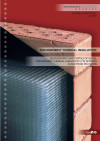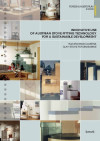Suchergebnisse für "Factsheet: Energietechnologien gestalten, die für alle sinnvoll und nutzbar sind"
Transparent Thermal Insulation

Development and Testing of novel Transparent Thermal Insulatio (TTI) Systems made from Polymers
Forschungsforum
2/2002
Herausgeber: BMVIT
Englisch, 6 Seiten
Downloads zur Publikation
Innovative Use Of Austrian Stove Fitting Technology For A Sustainabl Development

Tile stoves in Austria - Clay stoves in Zimbabwe
Forschungsforum
2/2000
Herausgeber: BMVIT
Englisch, 6 Seiten
Downloads zur Publikation
First passive-house school reconstruction

Factor 10 refurbishment of the General Secondary School II and Polytechnic School of Schwanenstadt (Upper Austria) with prefabricated wooden façade elements and with a comfort ventilation system.
Sanierung PRO!

The goal of the project is the development of a guideline, which supports builders and planners or consultants in the organization and monitoring of inhabitant integration into the reorganization processes of multi-storey housing.
old house? old house!

The renovation and restructuring of existing housing stock using modern, ecologically efficient building technology as a means for developing Assisted Living Centres for senior citizens within an urban context
Sunny research! Sustainable building design with high energy performance for a modern commercial building

Commercial buildings of basic to medium standard are hardly ever designed by a high quality of innovative building services engineering. In the project Sunny research! a sustainable building design with high energy performance was developed. The aim was to adapt the aspects of Renewable Energy, thermal comfort and wellness in work.
User-friendly heating and ventilation systems for low energy and passivehouses

The goal of the research project is the evaluation of different heating and ventilation systems for passive- and low energy multi family and office buildings taking into account indoor climate, possible variation of user behaviour, final and primary energy demand, costs, space demand and fail save installation and operation.
Existing building reconstruction and implementation of passive house components

Implementation of passive house components, systems and techniques into the practice of existing building reconstruction, in order to reduce the energy consumption as much as possible and to increase the living quality substantially. Craftspeople and planners, who are specialized in building renovation, should gain access to passive house know-how.
Optimization of energy supply

The purpose of the work is to analyze the possibilities of the reduction of the energy demand of residential buildings by using telecommunication technologies such as mobile phones or Internet. Lowering room and water temperature during the absence of the inhabitants are of particular relevance.
Ways and means to increase the construction-volume by 500%, by means of standardised thermal restoration of old houses.

Development of practise-fit methods for intensification and rationalisation of processes in the field of restoration of one-and two-family houses built between 1945 and 1982 in Austria.
green LIGHT: light, fresh air, exterior space, greening in the large volume PassivHaus

theoretical topics: Optimization of natural light, ambient humidity and of private exterior space, planted over buildings, evaluation of the energetic performance and special challenges of large volume "Passivhaus" residential buildings. applied research: concept for the renovation of a 13 storey residential building for senior citizens built in 1974 to PassivHaus standards, applying the results attained in the theoretical part.
Comfort for sustainability

Research project on comfort and on the health and recreational value of passive houses
home dreams

Listening to the inhabitants of innovative buildings and using their satisfactory and unsatisfactory experiences as the basis for drawing up practice based criteria and recommendations for a quality, user-orientated building policy. The target groups are funding bodies, building contractors and town planners.
